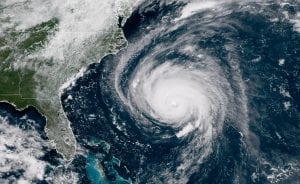Virtual Physician Teams Stand Ready to Ensure Continuity of Care Before, During, After Catastrophic Storms
ATLANTA (Sept. 5, 2019) — Eagle Telemedicine announced today that its telehospitalists stand ready to support its hospital partners in the path of Hurricane Dorian and throughout hurricane season when other catastrophic storms threaten to disrupt patient care on the East Coast.
“As we did during Hurricane Florence last September, Eagle’s team of virtual physicians is ready to help any of our partner hospitals when catastrophic storms threaten,” said David Cooke, vice president of operations and chief compliance officer for Eagle.
“As storms like Hurricane Dorian start to build, we stay mindful of their path. After we identify the threatened hospitals, we work with each of them to confirm backup access and test any systems that could prove invaluable during the storm, such as satellite phones. We also provide coverage for on-the-ground physicians who are unable to get to a facility because of road closures, and post-storm follow-up. Working together, we help ensure continuity of care before, during and after the event.
”In addition, Eagle closely monitors storms to see if any of Eagle’s virtual physicians are in potentially affected areas. Eagle works with them on possible evacuation plans and offers backup coverage from other members of the Eagle team who are out of harm’s way.
North Carolina Coastal Hospital’s Experience Provides a Model
Last year, when Hurricane Florence hit the North Carolina coast in the biggest natural disaster in the state’s history, a seven-county hospital system using Eagle’s TeleNocturnist program was able to rely on backup coverage from the Eagle physician team for local physicians who weren’t able to get to the facilities where they worked, and respite services for those who were on duty at the hospitals.

IN SPACE – SEPTEMBER 12: In this satellite image provided by U.S. National Oceanic and Atmospheric Administration (NOAA), Hurricane Florence churns through the Atlantic Ocean toward the U.S. East Coast on September 12, 2018. Florence slowed its approach to the U.S. today and was forecast to turn south, stalling along the North Carolina and South Carolina coast and bringing with it torrential rain, high winds and a dangerous storm surge tomorrow through Saturday. (Photo by NOAA via Getty Images)
Since then, the experience has become a model for Eagle’s plan of response when other storms threaten. In addition, the North Carolina hospital system has incorporated Eagle Telemedicine into its crisis management plan for future disasters.
Even though the hospitals did have to switch to generator power and lost the Internet connection required to use the two-way videoconferencing “robot” for telemedicine care, satellite phone connections with Eagle physicians were a valuable lifeline and safety net for on-the-ground clinical teams and residents who needed help once Florence struck.
During the storm, for example, flooding and downed power lines prevented one local resident from evacuating his home. When his prescribed supply of oxygen ran out, he called the ambulance, came to one of the hospitals’ emergency departments (ED) and was admitted for COPD exacerbation. Eagle’s virtual physician team helped sort out the issue and coordinate social services to help get him a new oxygen tank and make sure it was safe to return home.
The Eagle team also helped treat a patient who was admitted with chest pain after trying to remove furniture from his house when flooding began. Via telemedicine, several other patients were admitted with respiratory issues from lack of oxygen during the power outage, as well as asthma symptoms that were exacerbated by mold and mildew.
“Storms like Florence and Dorian aren’t the primary reason our partner hospitals use our telemedicine services, but once these storms strike, they prove telemedicine’s flexibility in the face of crisis,” Cooke said. “We can provide clinical coverage from virtually anywhere to hospitals that—for whatever reason—are underserved.”